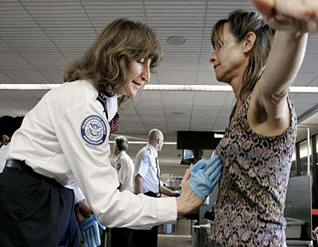|
|||||||||||
|
|
|
|||
|
By Shane Nolan |
||||
 |
November 25, 2010 - As airports brace for the busiest
days of the year, two groups won’t be holding up the
security lines pilots and flight attendants. Media
outlets, including the Monitor, widely reported the
pilots’ deal last week, but fewer have noted that flight
attendants will receive the same treatment.
Security officials acknowledged in a deal brokered on
November 19 between unions and the TSA that the people
who have unfettered access to the cockpit do not need to
undergo invasive screening procedures as part of their
daily commute. “It just doesn’t make sense we spend our resources doing this intensive security check on workers who are in a safety-sensitive position and who have been screened before they are allowed to get the job," says Patricia Friend, president of the Association of Flight Attendants. |
|||
|
|
||||
|
CWA, which
represents more than 50,000 flight attendants at 22 airlines.
Many passengers don’t realize how much cockpit access flight
attendants have, she adds. “When a pilot steps out of the
cockpit, a flight attendant must be in the cockpit.”
Passengers
have also complained loudly about the invasive scans, which
render a naked image, and the “enhanced pat-downs,” which
require whole-hand rubbing against all parts of the body. Most
passengers fly infrequently, however, making checkpoint
screenings a rare indignity.
For those
who go through checkpoints daily, the risks – and indignities –
are larger. Pilots’ unions, concerned about the
disproportionately high exposure to the scans’ radiation, urged
their members not to walk through the Advanced Imaging
Technology scanners, pointing out that there are no long-term
studies looking at cumulative effects on pregnant women, those
with compromised immune systems, and others. Pilots and flight attendants in uniform are still subject to security, but as of Friday, they get what everyone got until last month: a walk through a metal detector and, if that gets triggered, a quick secondary screening. The metal-detecting wands are gone for good, but the secondary scan for airplane crew will be the back-of-the-hands pat-down that passengers remember from before the new protocols went into place on November 1.
In order
to become a flight attendant, a man or woman – and it’s usually
a woman, in this industry with more than five women on the job
for each man – must be fingerprinted and receive a detailed
10-year background check. |
||||


